Harris C.M., Piersol A.G. Harris Shock and vibration handbook
Подождите немного. Документ загружается.


CHAPTER 24
VIBRATION OF STRUCTURES
INDUCED BY
GROUND MOTION
W. J. Hall
INTRODUCTION
This chapter discusses typical sources of ground motion that affect buildings, the
effects of ground motion on simple structures, response spectra, design response
spectra (also called design spectra), and design response spectra for inelastic systems.
The importance of these topics is reflected in the fact that such characterizations
normally form the loading input for many aspects of shock-related design, including
seismic design. Selected material are presented which are pertinent to the design of
resisting systems, for example, buildings designed to meet code requirements related
to earthquakes.
GROUND MOTION
SOURCE OF GROUND MOTION
Ground motion may arise from any number of sources such as earthquake excita-
tion
1,2
(described in detail in this chapter), high explosive,
3
or nuclear device detona-
tions.
4
In such cases, the source excitation can lead to major vibration of the primary
structure or facility and its many parts, as well as to transient and permanent trans-
lation and rotation of the ground on which the facility is constructed. Detonations
may result in drag and side-on overpressures, ballistic ejecta, and thermal and radia-
tion effects.
Other sources of ground excitation, although usually not as strong, can be
equally troublesome. For example, the location of a precision machine shop near a
railroad or highway, or of delicate laboratory apparatus in a plant area containing
heavy drop forging machinery or unbalanced rotating machinery are typical of
situations in which ground-transmitted vibrations may pose serious problems.
24.1
8434_Harris_24_b.qxd 09/20/2001 11:59 AM Page 24.1

Another different class of vibrational problems arises from excitation of the pri-
mary structure by other sources, e.g., wind blowing on a bridge, earthquake excita-
tion of a building, or people walking or dancing on a floor in a building. Vibration
of the primary structure in turn can affect secondary elements such as mounted
equipment and people located on a floor (in the case of buildings) and vehicles or
equipment (in the case of bridges).A brief summary of such people-structure inter-
action is given in Ref. 5.
The variables involved in problems of this type are exceedingly numerous and,
with the exception of earthquakes, few specific well-defined measurements are gen-
erally available to serve as a guide in estimating the ground motions that might be
used as computational guidelines in particular cases. A number of acceleration-vs.-
time curves for typical ground motions arising from the operation of machines and
vehicles are shown in Fig. 24.1. Another record arising from a rock quarry blast is
shown in Fig. 24.2. Although the records differ somewhat in their characteristics, all
can be compared directly with similar measurements of earthquakes, and response
computations generally are handled in the same manner.
In most cases, to analyze and evaluate such information one needs to (1) develop
an understanding of the source and nature of the vibration, (2) ascertain the physi-
cal characteristics of the structure or element, (3) develop an approach for modeling
and analysis, (4) carry out the analysis, (5) study the response (with parameter vari-
ations if needed), (6) evaluate the behavior of service and function limit states, and
(7) develop, in light of the results of the analysis, possible courses of corrective
action, if required. Merely changing the mass, stiffness, or damping of the structural
system may or may not lead to acceptable corrective action in the sense of a reduc-
tion in deflections or stresses; careful investigation of the various alternatives is
required to change the response to an acceptable limit. Advice on these matters is
contained in Refs. 3, 6, and 7.
RESPONSE OF SIMPLE STRUCTURES TO GROUND MOTIONS
Four structures of varying size and complexity are shown in Fig. 24.3: (A) a simple,
relatively compact machine anchored to a foundation, (B) a 15-story building, (C) a
40-story building, and (D) an elevated water tank. The dynamic response of each of
the structures shown in Fig. 24.3 can be approximated by representing each as a sim-
ple mechanical oscillator consisting of a single mass supported by a spring and a
damper as shown in Fig. 24.4. The relationship between the undamped angular fre-
quency of vibration ω
n
= 2πf
n
, the natural frequency f
n
, and the period T is defined
in terms of the spring constant k and the mass m:
ω
n
2
= (24.1)
f
n
== =
(24.2)
In general, the effect of the damper is to produce damping of free vibrations or
to reduce the amplitude of forced vibrations. The damping force is assumed to be
equal to a damping coefficient c times the velocity ˙u of the mass relative to the
ground. The value of c at which the motion loses its vibratory character in free
vibration is called the critical damping coefficient; for example, c
c
= 2mω
n
.The
amount of damping is most conveniently considered in terms of the fraction of crit-
ical damping, ζ [see Eq. (2.12)],
k
m
1
2π
ω
n
2π
1
T
k
m
24.2 CHAPTER TWENTY-FOUR
8434_Harris_24_b.qxd 09/20/2001 11:59 AM Page 24.2
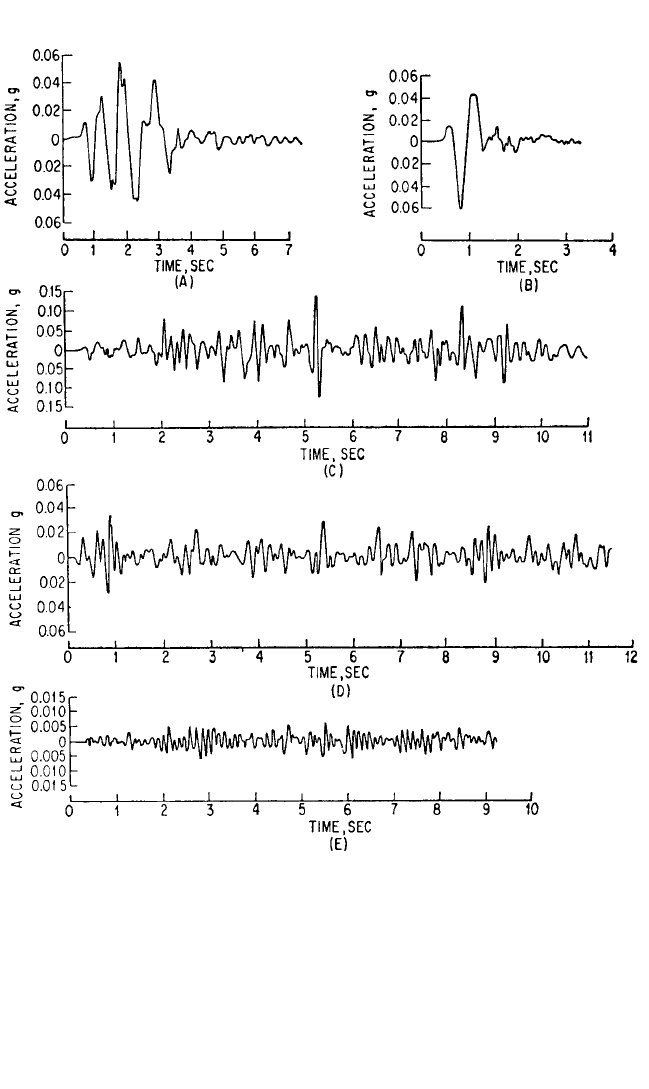
VIBRATION OF STRUCTURES INDUCED BY GROUND MOTION 24.3
FIGURE 24.1 Ground-acceleration-vs.-time curves for typical machine and vehicle excitations. (A)
Vertical acceleration measured on a concrete floor on sandy loam soil at a point 6 ft from the base of
a drop hammer. (B) Horizontal acceleration 50 ft from drop hammer. The weight of the drop ham-
merhead was approximately 15,000 lb, and the hammer was mounted on three layers of 12- by 12-in.
oak timbers on a large concrete base. (C) Vertical acceleration 6 ft from a railroad track on the well-
maintained right-of-way of a major railroad during passing of luxury-type passenger cars at a speed
of approximately 20 mph. The accelerometer was bolted to a 2- by 2-in. by 2
1
⁄2-in. steel block which
was firmly anchored to the ground. (D) Horizontal acceleration of the ground at 46 ft from the above
railroad track, with a triple diesel-electric power unit passing at a speed of approximately 20 mph. (E)
Horizontal acceleration of the ground 6 ft from the edge of a relatively smooth highway, with a large
tractor and trailer unit passing on the outside lane at approximately 35 mph with a full load of gravel.
6
8434_Harris_24_b.qxd 09/20/2001 11:59 AM Page 24.3
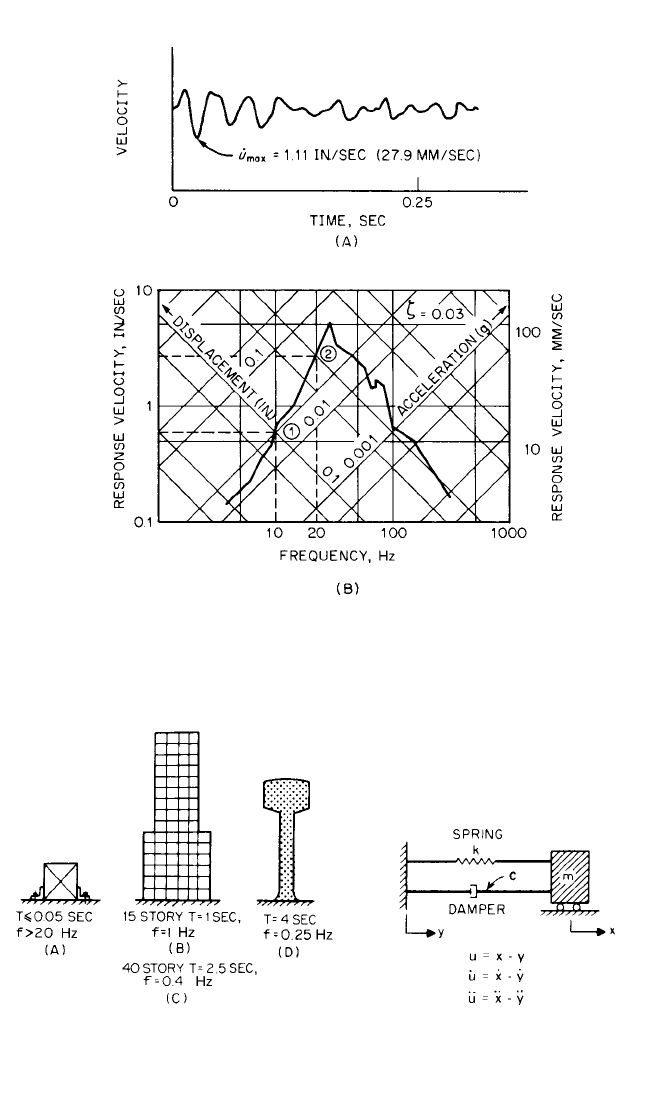
24.4 CHAPTER TWENTY-FOUR
FIGURE 24.2 Typical quarry blast data. (A) Time-history of velocity
taken by a velocity transducer and recorder. (B) Corresponding
response spectrum computed from the record in (A) using Duhamel’s
integral.
3
FIGURE 24.3 Structures subjected to earth-
quake ground motion. (A) A machine anchored
to a foundation. (B) A 15-story building. (C) A
40-story building. (D) An elevated water tank.
FIGURE 24.4 System definition; the dynamic
response of each of the structures shown in
Fig. 24.3 can be approximated by this simple
mechanical oscillator.
8434_Harris_24_b.qxd 09/20/2001 11:59 AM Page 24.4
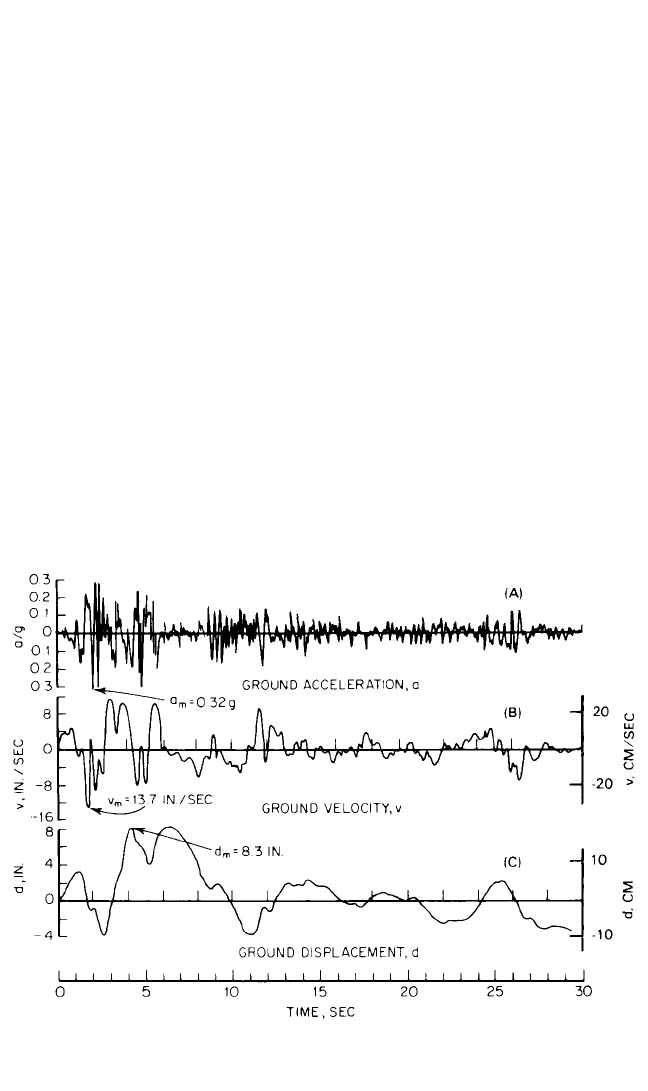
ζ= = (24.3)
For most practical structures ζ is relatively small, in the range of 0.005 to 0.2 (i.e., 0.5
to 20 percent), and does not appreciably affect the natural period or frequency of
vibration (see Refs. 1b and 8).
EARTHQUAKE GROUND MOTION
Strong-motion earthquake acceleration records with respect to time have been
obtained for a number of earthquakes. Ground motions from other sources of dis-
turbance, such as quarry blasting and nuclear blasting, also are available and show
many of the same characteristics. As an example of the application of such time-
history records, the recorded accelerogram for the El Centro, California, earthquake
of May 18, 1940, in the north-south component of horizontal motion is shown in Fig.
24.5. On the same figure are shown the integration of the ground acceleration a to
give the variation of ground velocity v with time and the integration of velocity to
give the variation of ground displacement d with time. These integrations normally
require baseline corrections of various sorts, and the magnitude of the maximum
displacement may vary depending on how the corrections are made. The maximum
velocity is relatively insensitive to the corrections, however. For this earthquake,
with the integrations shown in Fig. 24.5, the maximum ground acceleration is 0.32g,
the maximum ground velocity is 13.7 in./sec (35 cm/sec), and the maximum ground
c
2mω
n
c
c
c
VIBRATION OF STRUCTURES INDUCED BY GROUND MOTION 24.5
FIGURE 24.5 El Centro, California, earthquake of May 18, 1940, north-south component. (A)
Record of the ground acceleration. (B) Variation of ground velocity v with time, obtained by integra-
tion of (A). (C) Variation of ground displacement with time, obtained by integration of (B).
8434_Harris_24_b.qxd 09/20/2001 11:59 AM Page 24.5

displacement is 8.3 in. (21 cm). These three maximum values are of particular inter-
est because they help to define the response motions of the various structures con-
sidered in Fig. 24.3 most accurately if all three maxima are taken into account.
RESPONSE SPECTRA
ELASTIC SYSTEMS
The response of the simple oscillator shown in Fig. 24.4 to any type of ground motion
can be readily computed as a function of time. A plot of the maximum values of the
response, as a function of frequency or period, is commonly called a response spec-
trum (or shock response spectrum). The response spectrum may be defined as the
graphical relationship of the maximum response of a single degree-of-freedom lin-
ear system to dynamic motions or forces. This concept of a response spectrum is
widely used in the study of the response of simple oscillators to transient distur-
bances; for a number of examples, see Chaps. 8 and 23.
A careful study of Fig. 24.4 will reveal that there are nine quantities represented
there: acceleration, velocity, and displacement of the base, mass, and their relative
values denoted by u. Commonly the maxima of interest are the maximum deforma-
tion of the spring, the maximum spring force, the maximum acceleration of the mass
(which is directly related to the spring force when there is no damping), or a quan-
tity having the dimensions of velocity, which provides a measure of the maximum
energy absorbed in the spring. The details of various forms of response spectra that
can be graphically represented, uses of response spectra, and techniques for com-
puting them are discussed in detail in Refs. 1b, 1c, and 1d. A brief treatment of the
applications of response spectra follows.The maximum values of the response are of
particular interest. These maxima can be stated in terms of the maximum strain in
the spring u
m
= D, the maximum spring force, the maximum acceleration A of the
mass (which is related to the maximum spring force directly when there is no damp-
ing), or a quantity, having the dimensions of velocity, which gives a measure of the
maximum energy absorbed in the spring.This quantity, designated the pseudo veloc-
ity V, is defined in such a way that the energy absorption in the spring is
1
⁄2 mV
2
.The
relations among the maximum relative displacement of the spring D, the pseudo
velocity V, and the pseudo acceleration A, which is a measure of the force in the
spring, are
V =ωD (24.4)
and A =ωV =ω
2
D (24.5)
The pseudo velocity V is nearly equal to the maximum relative velocity for sys-
tems with moderate or high frequencies but may differ considerably from the maxi-
mum relative velocity for very low frequency systems. The pseudo acceleration A is
exactly equal to the maximum acceleration for systems with no damping and is not
greatly different from the maximum acceleration for systems with moderate
amounts of damping, over the whole range of frequencies from very low to very high
values.
Typical plots of the response of the system to a base excitation, as a function of
period or natural frequency, are called response spectra (also called shock spectra).
Plots for acceleration and for relative displacement, for a system with a moderate
amount of damping and subjected to an input similar to that of Fig. 24.5, can be
24.6 CHAPTER TWENTY-FOUR
8434_Harris_24_b.qxd 09/20/2001 11:59 AM Page 24.6
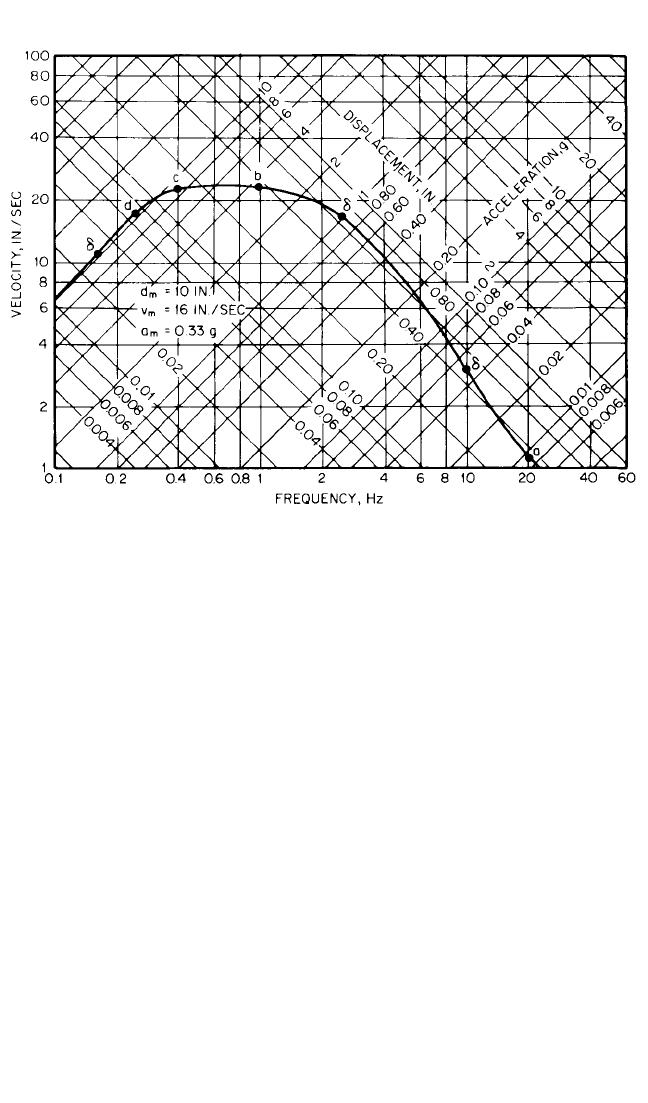
made. This arithmetic plot of maximum response is simple and convenient to use.
Various techniques of computing and plotting spectra may be found in the refer-
ences cited at the end of this chapter, especially in Refs. 1c, 1d, and 6 to 18.
A somewhat more useful plot, which indicates the values for D, V, and A, is shown
in Fig. 24.6. This plot has the virtue that it also indicates more clearly the extreme or
limits of the various parameters defining the response.All parameters are plotted on
a logarithmic scale. Since the frequency is the reciprocal of the period, the logarith-
mic scale for the period would have exactly the same spacing of the points, or in
effect the scale for the period would be turned end for end. The pseudo velocity is
plotted on a vertical scale.Then on diagonal scales along an axis that extends upward
from right to left are plotted values of the displacement, and along an axis that
extends upward from left to right the pseudo acceleration is plotted, in such a way
that any one point defines for a given frequency the displacement D, the pseudo
velocity V, and the pseudo acceleration A. Points are indicated in Fig. 24.6 for the
several structures of Fig. 24.3 plotted at their approximate fundamental frequencies.
Many other formats are used in plotting spectra; for example, u, ˙u, ω u, or ¨x vs. time.
Such examples are shown in Ref. 1d.
Much of the work on spectra, described above, has been developed on the basis
of studying strong ground motion categorized by ground motion acceleration level
scaling. Another important aspect of statistical study, described in Ref. 19, concerns
both ground motions and spectra based on magnitude scaling.
In developing spectral relationships, a wide variety of motions have been con-
sidered,
20
ranging from simple pulses of displacement, velocity, or acceleration of
the ground, through more complex motions such as those arising from nuclear-
blast detonations, and for a variety of earthquakes as taken from available strong-
VIBRATION OF STRUCTURES INDUCED BY GROUND MOTION 24.7
FIGURE 24.6 Smooth response spectrum for typical earthquake.
8434_Harris_24_b.qxd 09/20/2001 11:59 AM Page 24.7
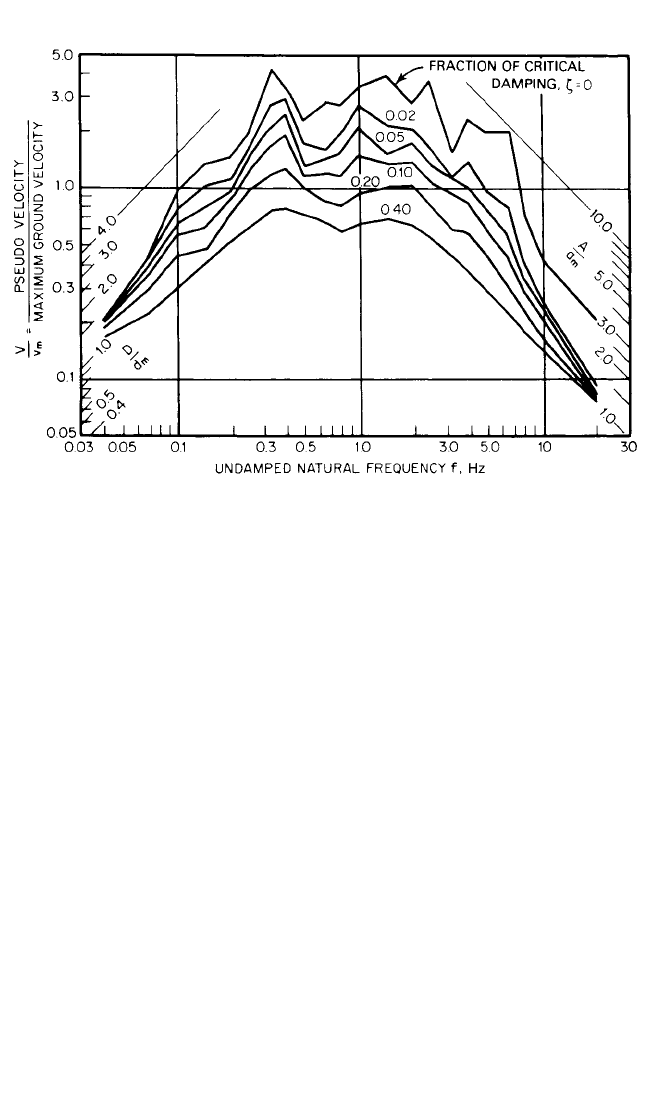
motion records. Response spectra for the El Centro earthquake are shown in Fig.
24.7. The spectrum for small amounts of damping is much more jagged than indi-
cated by Fig. 24.6, but for the higher amounts of damping the response curves are
relatively smooth. The scales are chosen in this instance to represent the amplifi-
cations of the response relative to the ground-motion values of displacement,
velocity, or acceleration.
The spectra shown in Fig. 24.7 are typical of response spectra for nearly all types
of ground motion. On the extreme left, corresponding to very low-frequency sys-
tems, the response for all degrees of damping approaches an asymptote correspon-
ding to the value of the maximum ground displacement. A low-frequency system
corresponds to one having a very heavy mass and a very light spring. When the
ground moves relatively rapidly, the mass does not have time to move, and therefore
the maximum strain in the spring is precisely equal to the maximum displacement of
the ground. For a very high-frequency system, the spring is relatively stiff and the
mass very light.Therefore, when the ground moves, the stiff spring forces the mass to
move in the same way the ground moves, and the mass therefore must have the same
acceleration as the ground at every instant. Hence, the force in the spring is that
required to move the mass with the same acceleration as the ground, and the maxi-
mum acceleration of the mass is precisely equal to the maximum acceleration of the
ground. This is shown by the fact that all the lines on the extreme right-hand side of
the figure asymptotically approach the maximum ground-acceleration line.
For intermediate-frequency systems, there is an amplification of the motion. In
general, the amplification factor for displacement is less than that for velocity, which
in turn is less than that for acceleration. Peak amplification factors for the
undamped system (ζ=0) in Fig. 24.7 are on the order of about 3.5 for displacement,
4.2 for velocity, and 9.5 for acceleration.
24.8 CHAPTER TWENTY-FOUR
FIGURE 24.7 Response spectra for elastic systems subjected to the El Centro earthquake for var-
ious values of fraction of critical damping ζ.
8434_Harris_24_b.qxd 09/20/2001 11:59 AM Page 24.8
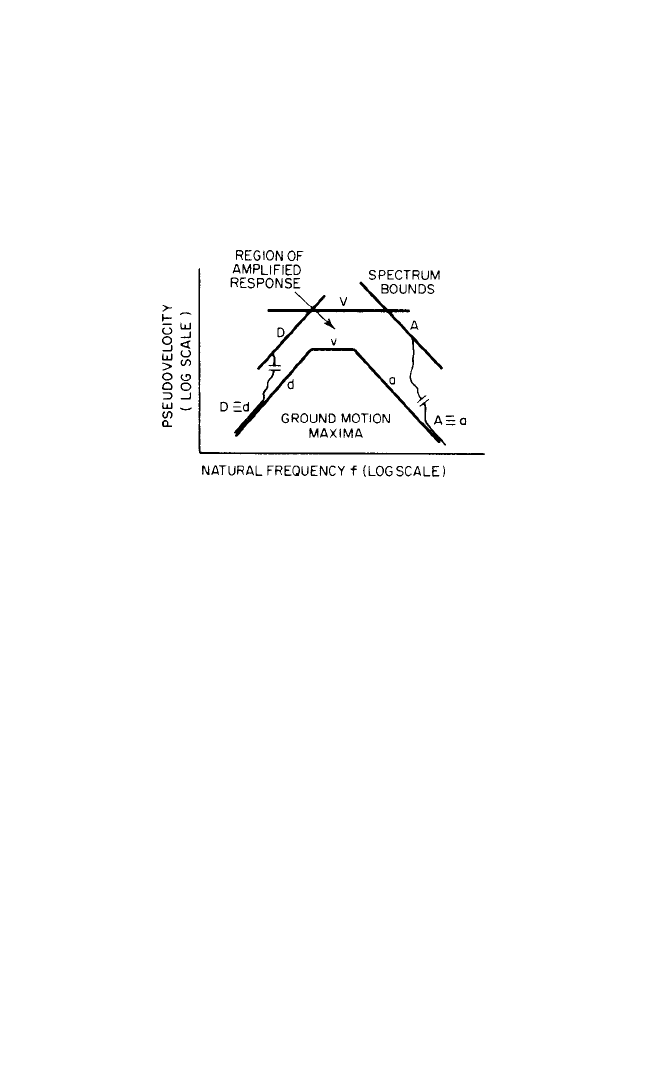
The results of similar calculations for other ground motions are quite consistent
with those in Fig. 24.7, even for simple motions. The general nature of the response
spectrum shown in Fig. 24.8 consists of a central region of amplified response and
two limiting regions of response in which for low-frequency systems the response
displacement is equal to the maximum ground displacement, and for high-frequency
systems the response acceleration is equal to the maximum ground acceleration.
Values of the amplification factor reasonable for use in design are presented in the
next sections.
DESIGN RESPONSE SPECTRA
A response spectrum developed to give design coefficients is called a design
response spectrum or a design spectrum. As an example of its use in seismic design,
for any given site, estimates are made of the maximum ground acceleration, maxi-
mum ground velocity, and maximum ground displacement. The lines representing
these values can be drawn on the tripartite logarithmic chart of which Fig. 24.9 is
an example. The heavy lines showing the ground-motion maxima in Fig. 24.9 are
drawn for a maximum ground acceleration a of 1.0g, a velocity v of 48 in./sec (122
cm/sec), and a displacement d of 36 in. (91.5 cm). These data represent motions
more intense than those generally considered for any postulated design earth-
quake hazard. They are, however, approximately in correct proportion for a num-
ber of areas of the world, where earthquakes occur either on firm ground, soft
rock, or competent sediments of various kinds. For relatively soft sediments, the
velocities and displacements might require increases above the values correspon-
ding to the given acceleration as scaled from Fig. 24.9, and for competent rock, the
velocity and displacement values would be expected to be somewhat less. More
detail can be found in Refs. 1c and d. It is not likely that maximum ground veloci-
ties in excess of 4 to 5 ft/sec (1.2 to 1.5 m/sec) are obtainable under any circum-
stances.
On the basis of studies of horizontal and vertical directions of excitation for var-
ious values of damping,
1c,10,11
representative amplification factors for the 50th and
84.1th percentile levels of horizontal response are presented in Table 24.1. The
84.1th percentile means that one could expect 84.1 percent of the values to fall at or
below that particular amplification. With these amplification factors and noting
VIBRATION OF STRUCTURES INDUCED BY GROUND MOTION 24.9
FIGURE 24.8 Typical tripartite logarithmic plot
of response-spectrum bounds compared with
maximum ground motion.
8434_Harris_24_b.qxd 09/20/2001 11:59 AM Page 24.9
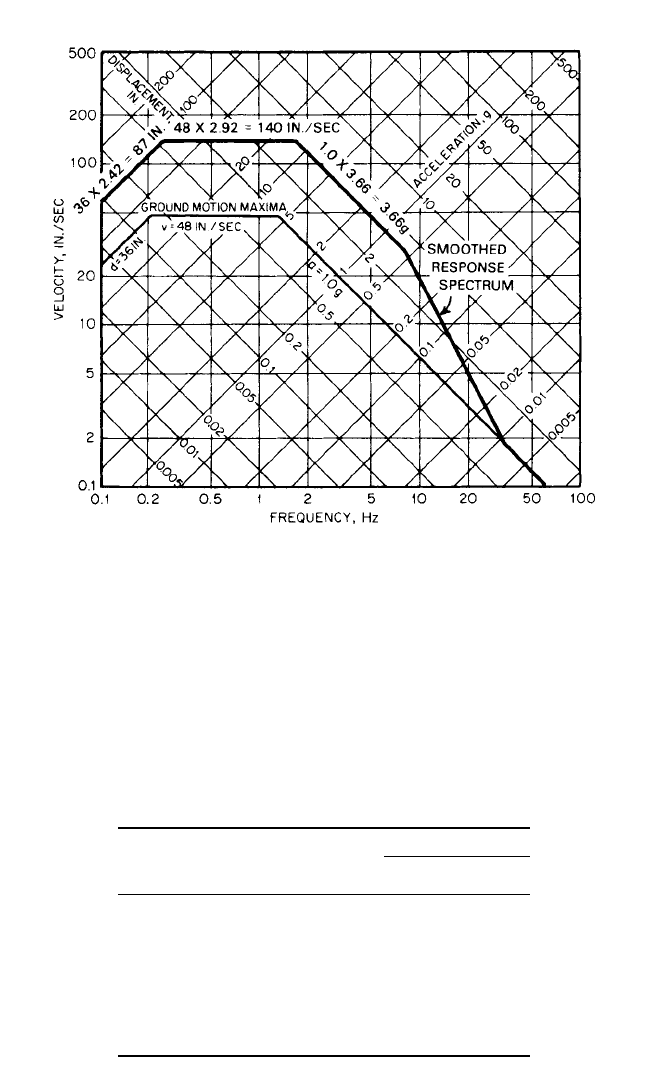
points B and A to fall at about 8 and 33 Hz, the spectra may be constructed as
shown in Fig. 24.9 by multiplying the ground maxima values of acceleration, veloc-
ity, and displacement by the appropriate amplification factors. Further information
on, and other approaches to, construction of design spectra may be found in Refs.
1c and d.
TABLE 24.1 Values of Spectrum Amplification Factors
1c,11
Damping, percent Amplification factor
of critical
Percentile damping DVA
50th 0.5 2.01 2.59 3.68
2.0 1.63 2.03 2.74
5.0 1.39 1.65 2.12
10.0 1.20 1.37 1.64
84.1th 0.5 3.04 3.84 5.10
2.0 2.42 2.92 3.66
5.0 2.01 2.30 2.71
10.0 1.69 1.84 1.99
24.10 CHAPTER TWENTY-FOUR
FIGURE 24.9 Basic design spectrum normalized to 1.0g for a value of damping
equal to 2 percent of critical, 84.1th percentile level. The spectrum bound values are
obtained by multiplying the appropriate ground-motion maxima by the correspon-
ding amplification value of Table 24.1.
8434_Harris_24_b.qxd 09/20/2001 11:59 AM Page 24.10
